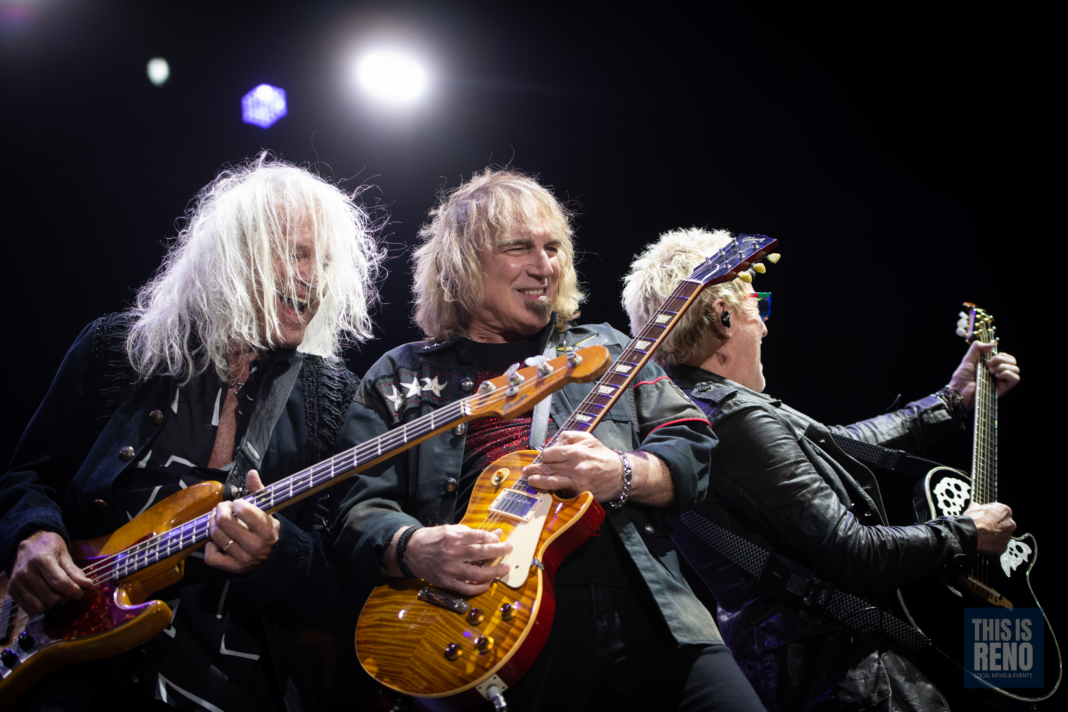Rock icons Styx and REO Speedwagon treated a packed Nugget Event Center on Friday in Sparks to a night full of hits.
REO and Styx are two sides of the ’70s rock coin. Both radio familiars, REO distributes sweet classic rock love ballads and leans into an arena rock sound. Styx is more progressive, genre-bending and harder-hitting at times.
REO Speedwagon surpasses all expectations for a show’s opener. In between powerhouse hits like “Can’t Fight This Feeling” and “Take It on the Run,” they dipped into anecdotes about the band’s history and cleverly turned “Live Every Moment” into a snippet cover of Crosby, Stills & Nash’s “Judy Blue Eyes.”
Their music is anthemic with a touch of cheesiness. I love cheese.
Frontman Kevin Cronin plays the open-tuning guitar opening of “Time for Me to Fly” the same way he did in the ’70s—left thumb over the neck, barring the entire chord. The audience was ecstatic.
Cronin dipped into a fantastic boomer tangent, talking shit about performers who use iPads for lyrics onstage or backing tracks and pitch correction helping backstage.
“With us, what you see is what you get,” Cronin said.
He went on to say, “people make mistakes.”
“Some of the best times I’ve had have been mistakes,” Cronin said.
Cronin told stories about his recent travels abroad and circled back around to how much he loves it here at home. He seems like a sweet, genuine person. I’d love to see a Dana Carvey micro impersonation of him.
After drum and bass solos, Cronin told the story of how he met bassist Bruce Hall, and how much he wanted to work with him. Hall then took over lead vocals for “Back on the Road Again.” These dudes were born in the ’50s, and they still kick ass.
I’ve always thought “Ridin’ the Storm Out” was a standout tune in their catalog. Wikipedia now tells me that Cronin left the band, and Mike Murphy fronted the band throughout the recording. The song then became popular from a live album after Cronin’s return. Oh, the tangled webs we weave.
REO Speedwagon finished on the high of “Roll With the Changes,” and it was time for the legends to fly.
Styx has roots in the Midwest as well. The Chicago legends started the band 52 years ago, a half-century of music spanning 17 studio albums.
Styx is excitement. They throw out classic rock jams like “Renegade,” they cut deep with keyboard-led ballads like “Babe,” but there’s also a thread of Broadway theater with science fiction and mythological themes.
Just like Chicago would have been fine with either Kath or Cetera, Styx could totally get by with the style and hits of one of their frontmen. The inclusion of multiple writers and singers is a common thread through progressive music. King Crimson and Genesis put on masterclasses.
Most Styx big choruses feature one of their two lead singers, Tommy Shaw or Lawrence Gowan, going back and forth with a choir of falsetto backups shouting things like “Miss America!”
“These are the best …” a frontman whispers.
“Of times!” everyone else responds with exuberance.
They offer fans so much variety. Their concept album “Kilroy Was Here” starts with dancy nerd anthem “Mr. Roboto,” then two tracks later they downshift to “Don’t Let It End,” which is gentle, as if from a different band. Dennis DeYoung was an entrancing songwriter.
Shaw, the other half of their songwriting team, dynamically switches from lead guitar solos to powerful vocals onstage. He joined the band in 1975, a few years into their career after hits like “Lady” and “Lorelei.”
They’re a wild band. Shaw’s first involvement in the band yielded “Crystal Ball,” a favorite song and album that also features Debussy’s “Clair de Lune,” just ’cuz. A couple of albums later Shaw bought a mandolin, DeYoung pulled out an accordion, and they released “Boat on -the River,” an enchanting European-sounding folk tune. The climax of their third album, “The Serpent Is Rising,” is some proggy, psychedelic, jazzy, passageway-to-hell stuff.
They hit a stride with their 1977 release, “The Grand Illusion,” and pivoted out of the ’70s beautifully. Always shifting, always—get ready for it—progressing.
The first four songs of their set felt like a greatest hits album, bouncing from disco-y “Blue Collar Man (Long Nights)” to the epic title track of “The Grand Illusion” to “Lady” from 1973. Odd time signatures, genre shifts, and a random flute keep things interesting and fun for the audience and band.
Fusion is the spice of life and almost everything progressive is good. From Kansas to King Crimson, King Gizzard to Meshuggah, the gods in Yes, and don’t get me started on nu-metal and Ghost. (Oh no! He’s going for the jukebox.)
Gowan is a pinnacle showman. His keyboard platform spins as he plays. He often performs solos with his back turned toward the instrument. One hand flails wildly behind him as the other conducts the audience through the notes.
The keyboard intro to “Fooling Yourself (The Angry Young Man)” is iconic. It reminds me of the Main Street Electrical Parade at Disneyland.
Gowan commanded the venue and told the poor souls in the nearby condos that they’ll be in bed soon.
I was watching a fella standing in front of me as he typed a post to Facebook with his phone rather close to his face that read: “Styx blew REO Speedwagon off the stage!”
He’s not wrong.























